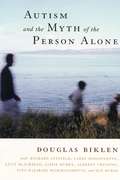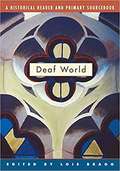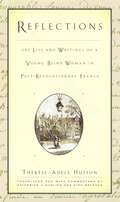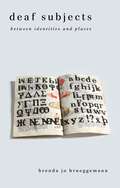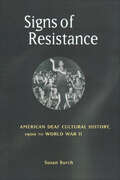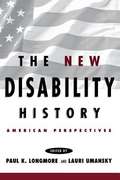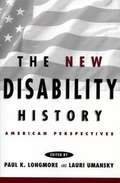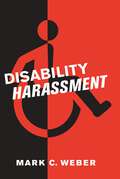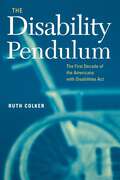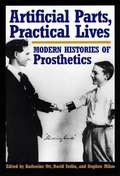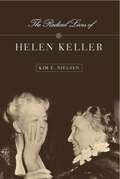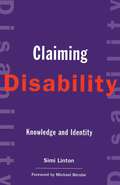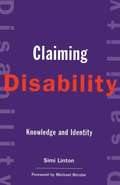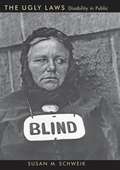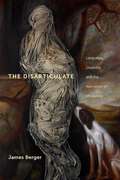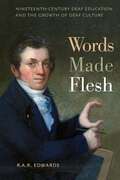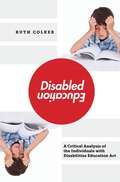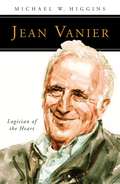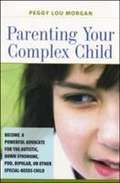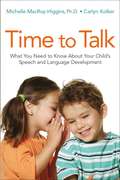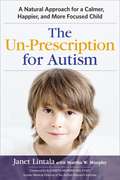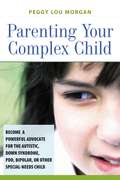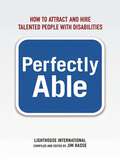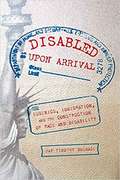- Table View
- List View
Autism and the Myth of the Person Alone
by Douglas BiklenAutism has been defined by experts as a developmental disorder affecting social and communication skills as well as verbal and nonverbal communication. It is said to occur in as many as 2 to 6 in 1,000 individuals. This book challenges the prevailing, tragic narrative of impairment that so often characterizes discussions about autism. Autism and the Myth of the Person Alone seriously engages the perspectives of people with autism, including those who have been considered as the most severely disabled within the autism spectrum. The heart of the book consists of chapters by people with autism themselves, either in an interview format with the author or written by themselves. Each author communicates either by typing or by a combination of speech and typing. These chapters are framed by a substantive introduction and conclusion that contextualize the book, the methodology, and the analysis, and situate it within a critical disability studies framework. The volume allows a look into the rich and insightful perspectives of people who have heretofore been thought of as uninterested in the world.
Deaf World: A Historical Reader and Primary Sourcebook
by Lois BraggTo many who hear, the deaf world is as foreign as a country never visited. Deaf World thus concerns itself less with the perspectives of the hearing and more with what Deaf people themselves think and do. Editor Lois Bragg asserts that English is for many signing people a second, infrequently used language and that Deaf culture is the socially transmitted pattern of behavior, values, beliefs, and expression of those who use American Sign Language. She has assembled an astonishing array of historical sources, political writings, and personal memoirs, from classic 19th-century manifestos to contemporary policy papers, on everything from eugenics to speech and lipreading, the right to work and marry, and the never-ending controversy over separation vs. social integration. At the heart of many of the selections lies the belief that Deaf Americans have long constituted an internal colony of sorts in the United States. While not attempting to speak for Deaf people en masse, this ambitious platform anthology places the Deaf on center stage, offering them an opportunity to represent the world--theirs as well as the hearing world--from a Deaf perspective. For Deaf readers, the book will be welcomed as a gift, both a companion to be savored and, as often, an opponent to be engaged and debated. And for the hearing, it serves as an unprecedented guide to a world and a culture so often overlooked. Comprising a judicious mix of published pieces and original essays solicited specifically for this volume, Deaf World marks a major contribution.
Reflections: The Life and Writings of a Young Blind Woman in Post-Revolutionary France (The History of Disability #5)
by Therese-Adèle HussonIn the 1820s, several years before Braille was invented, Therese-Adele Husson, a young blind woman from provincial France, wrote an audacious manifesto about her life, French society, and her hopes for the future. Through extensive research and scholarly detective work, authors Catherine Kudlick and Zina Weygand have rescued this intriguing woman and the remarkable story of her life and tragic death from obscurity, giving readers a rare look into a world recorded by an unlikely historical figure. Reflections is one of the earliest recorded manifestations of group solidarity among people with the same disability, advocating self-sufficiency and independence on the part of blind people, encouraging education for all blind children, and exploring gender roles for both men and women. Resolutely defying the sense of "otherness" which pervades discourse about the disabled, Husson instead convinces us that that blindness offers a fresh and important perspective on both history and ourselves. In rescuing this important historical account and recreating the life of an obscure but potent figure, Weygand and Kudlick have awakened a perspective that transcends time and which, ultimately, remaps our inherent ideas of physical sensibility
Deaf Subjects: Between Identities and Places (Cultural Front #12)
by Brenda Jo BrueggemannIn this probing exploration of what it means to be deaf, Brenda Brueggemann goes beyond any simple notion of identity politics to explore the very nature of identity itself. Looking at a variety of cultural texts, she brings her fascination with borders and between-places to expose and enrich our understanding of how deafness embodies itself in the world, in the visual, and in language.Taking on the creation of the modern deaf subject, Brueggemann ranges from the intersections of gender and deafness in the work of photographers Mary and Frances Allen at the turn of the last century, to the state of the field of Deaf Studies at the beginning of our new century. She explores the power and potential of American Sign Language—wedged, as she sees it, between letter-bound language and visual ways of learning—and argues for a rhetorical approach and digital future for ASL literature.The narration of deaf lives through writing becomes a pivot around which to imagine how digital media and documentary can be used to convey deaf life stories. Finally, she expands our notion of diversity within the deaf identity itself, takes on the complex relationship between deaf and hearing people, and offers compelling illustrations of the intertwined, and sometimes knotted, nature of individual and collective identities within Deaf culture.
Signs of Resistance: American Deaf Cultural History, 1900 to World War II (History of Disability)
by Susan BurchChoice Outstanding Academic Title 2003A reinterpretation of early 20th century Deaf history, with sign language at its center During the nineteenth century, American schools for deaf education regarded sign language as the "natural language" of Deaf people, using it as the principal mode of instruction and communication. These schools inadvertently became the seedbeds of an emerging Deaf community and culture. But beginning in the 1880s, an oralist movement developed that sought to suppress sign language, removing Deaf teachers and requiring deaf people to learn speech and lip reading. Historians have all assumed that in the early decades of the twentieth century oralism triumphed overwhelmingly. Susan Burch shows us that everyone has it wrong; not only did Deaf students continue to use sign language in schools, hearing teachers relied on it as well. In Signs of Resistance, Susan Burch persuasively reinterprets early twentieth century Deaf history: using community sources such as Deaf newspapers, memoirs, films, and oral (sign language) interviews, Burch shows how the Deaf community mobilized to defend sign language and Deaf teachers, in the process facilitating the formation of collective Deaf consciousness, identity and political organization.
The New Disability History: American Perspectives
by Paul K. Longmore Lauri UmanskyDisability has always been a preoccupation of American society and culture. From antebellum debates about qualification for citizenship to current controversies over access and reasonable accommodations, disability has been present, in penumbra if not in print, on virtually every page of American history. Yet historians have only recently begun the deep excavation necessary to retrieve lives shrouded in religious, then medical, and always deep-seated cultural, misunderstanding.<P> This volume opens up disability's hidden history. In these pages, a North Carolina Youth finds his identity as a deaf Southerner challenged in Civil War-era New York. Deaf community leaders ardently defend sign language in early 20th century America. The mythic Helen Keller and the long-forgotten American Blind People's higher Education and General Improvement Association each struggle to shape public and private roles for blind Americans. White and black disabled World War I and II veterans contest public policies and cultural values to claim their citizenship rights. Neurasthenic Alice James and injured turn-of-the-century railroadmen grapple with the interplay of disability and gender. Progressive-era rehabilitationists fashion programs to make crippled children economically productive and socially valid, and two Depression-era fathers murder their sons as public opinion blames the boys' mothers for having cherished the lads' lives. These and many other figures lead readers through hospital-schools, courtrooms, advocacy journals, and beyond to discover disability's past.<P> Coupling empirical evidence with the interdisciplinary tools and insights of disability studies, the book explores the complex meanings of disability as identity and cultural signifier in American history.
The New Disability History: American Perspectives
by Paul K. Longmore Lauri UmanskyIn a series of scholarly but highly readable essays, this book opens discussion on the role of disabled people in American history. It also examines how history has been affected by perceptions of disability. For example, one article looks at the ways disability has been used to strengthen prejudice against particular ethnic groups and to justify discrimination - "experts" have often claimed that one or another group of immigrants is genetically inferior and prone to mental retardation or physical frailty. One essay is based on the Civil War letters of a deaf man to his family. Another looks at the ways Helen Keller's Socialist beliefs were stifled by those around her.
Disability Harassment
by Mark C. WeberBuilding on the insights of both disability studies and civil rights scholars, Mark C. Weber frames his examination of disability harassment on the premise that disabled people are members of a minority group that must negotiate an artificial yet often damaging environment of physical and attitudinal barriers. The book considers courts' approaches to the problem of disability harassment, particularly the application of an analogy to race and sex harassment and the development of legal remedies and policy reforms under the Americans with Disabilities Act (ADA). While litigation under the ADA has addressed discrimination in public accommodations, employment, and education, Weber points out that the law has done little to combat disability harassment. He recommends that arguments based on unused provisions of the ADA should be developed and new legal remedies advanced to address the problem. Disability Harassment also draws on case law to explore special problems of harassment in the public schools, and closes with an appeal to judges and lawmakers for expanded legal protection against harassment.
The Disability Pendulum: The First Decade of the Americans With Disabilities Act (Critical America Series) (Critical America #39)
by Ruth ColkerSigned into law in July 1990, the Americans with Disabilities Act (ADA) became effective two years later, and court decisions about the law began to multiply in the middle of the decade. In The Disability Pendulum, Ruth Colker presents the first legislative history of the enactment of the ADA in Congress and analyzes the first decade of judicial decisions under the act. She assesses the success and failure of the first ten years of litigation under the ADA, focusing on its three major titles: employment, public entities, and public accommodations.The Disability Pendulum argues that despite an initial atmosphere of bipartisan support with the expectation that the ADA would make a significant difference in the lives of individuals with disabilities, judicial decisions have not been consistent with Congress' intentions. The courts have operated like a pendulum, at times swinging to a pro-disabled plaintiff and then back again to a pro-defendant stance. Colker, whose work on the ADA has been cited by the Supreme Court, offers insightful and practical suggestions on where to amend the act to make it more effective in defending disability rights, and also explains judicial hostility toward enforcing the act.
Artificial Parts, Practical Lives: Modern Histories of Prosthetics
by Katherine Ott David Serlin Stephen MihmThese essays are valuable first forays into the history of prosthetics. From the wooden teeth of George Washington to the Bly prosthesis, popular in the 1860s and boasting easy uniform motions of the limb, to today's lifelike approximations, prosthetic devices reveal the extent to which the evolution and design of technologies of the body are intertwined with both the practical and subjective needs of human beings. The peculiar history of prosthetic devices sheds light on the relationship between technological change and the civilizing process of modernity, and analyzes the concrete materials of prosthetics which carry with them ideologies of body, ideals, body politics, and culture. Simultaneously critiquing, historicizing, and theorizing prosthetics, Artificial Parts, Practical Lives lays out a balanced and complex picture of its subject, neither vilifying nor celebrating the merger of flesh and machine.
The Radical Lives of Helen Keller (The History of Disability #1)
by Kim E. NielsenA political biography that reveals new sides to Helen KellerSeveral decades after her death in 1968, Helen Keller remains one of the most widely recognized women of the twentieth century. But the fascinating story of her vivid political life—particularly her interest in radicalism and anti-capitalist activism—has been largely overwhelmed by the sentimentalized story of her as a young deaf-blind girl. Keller had many lives indeed. Best known for her advocacy on behalf of the blind, she was also a member of the socialist party, an advocate of women's suffrage, a defender of the radical International Workers of the World, and a supporter of birth control—and she served as one of the nation's most effective but unofficial international ambassadors. In spite of all her political work, though, Keller rarely explored the political dimensions of disability, adopting beliefs that were often seen as conservative, patronizing, and occasionally repugnant. Under the wing of Alexander Graham Bell, a controversial figure in the deaf community who promoted lip-reading over sign language, Keller became a proponent of oralism, thereby alienating herself from others in the deaf community who believed that a rich deaf culture was possible through sign language. But only by distancing herself from the deaf community was she able to maintain a public image as a one-of-a-kind miracle.Using analytic tools and new sources, Kim E. Nielsen's political biography of Helen Keller has many lives, teasing out the motivations for and implications of her political and personal revolutions to reveal a more complex and intriguing woman than the Helen Keller we thought we knew.
Claiming Disability: Knowledge and Identity (Cultural Front #14)
by Simi LintonFrom public transportation and education to adequate access to buildings, the social impact of disability has been felt everywhere since the passage of the Americans with Disabilities Act in 1990. And a remarkable groundswell of activism and critical literature has followed in this wake. Claiming Disability is the first comprehensive examination of Disability Studies as a field of inquiry. Disability Studies is not simply about the variations that exist in human behavior, appearance, functioning, sensory acuity, and cognitive processing but the meaning we make of those variations. With vivid imagery and numerous examples, Simi Linton explores the divisions society creates-the normal versus the pathological, the competent citizen versus the ward of the state. Map and manifesto, Claiming Disability overturns medicalized versions of disability and establishes disabled people and their allies as the rightful claimants to this territory.
Claiming Disability: Knowledge and Identity
by Simi LintonDisability studies in the humanities curriculum
The Ugly Laws: Disability in Public
by Susan SchweikIn 1881, the Chicago City Code read, "Any person who is diseased, maimed, mutilated, or in any way deformed... shall not... expose himself to public view." These "ugly laws" began in San Francisco in 1867, then spread through the U.S. and abroad; many in the U.S. weren't repealed until the 1970s. English professor Schweik (A Gulf So Deeply Cut: American Women Poets and the Second World War), co-director of UC Berkley's disabilities studies program, explores the emergence of these laws and their tragic consequences for thousands. Motivated largely by the desire to reduce beggar populations and to expand the role of charitable organizations, in practical terms the ugly laws meant "harsh policing; anti-begging; systematized suspicion...; and structural and institutional repulsion of disabled people." Schweik discusses the nineteenth-century conditions that created a demand for these laws, but notes how the resulting practices have carried through to the present. Schweik draws on a deep index of resources, from legal proceedings to out-of-print books, to tell the story of individuals long lost to history. Her detailed analysis will be of primary interest to those involved with the history of social justice in the U.S. and the passage of the Americans with Disabilities Act. 18 Illus. Copyright Reed Business Information, a division of Reed Elsevier Inc. All rights reserved.
The Disarticulate: Language, Disability, and the Narratives of Modernity (Cultural Front)
by James BergerLanguage is integral to oursocial being. But what is the status of those who stand outside of language?The mentally disabled, “wild” children, people with autism and otherneurological disorders, as well as animals, infants, angels, and artificialintelligences, have all engaged with language from a position at its borders.In the intricate verbal constructions of modern literature, the‘disarticulate’—those at the edges of language—have, paradoxically, playedessential, defining roles. Drawing on the disarticulate figures inmodern fictional works such as Billy Budd, The Sound and the Fury,Nightwood, White Noise, and The Echo Maker, among others,James Berger shows in this intellectually bracing study how these charactersmark sites at which aesthetic, philosophical, ethical, political, medical, andscientific discourses converge. It is also the place of the greatest ethicaltension, as society confronts the needs and desires of “the least of itsbrothers.” Berger argues that the disarticulate is that which is unaccountablein the discourses of modernity and thus stands as an alternative to theprevailing social order. Using literary history and theory, as well asdisability and trauma theory, he examines how these disarticulate figuresreveal modernity’s anxieties in terms of how it constructs its others.
Words Made Flesh: Nineteenth-Century Deaf Education and the Growth of Deaf Culture (The History of Disability #4)
by R. A. EdwardsDuring the early nineteenth century, schools for the deaf appeared in the United States for the first time. These schools were committed to the use of the sign language to educate deaf students. Manual education made the growth of the deaf community possible, for it gathered deaf people together in sizable numbers for the first time in American history. It also fueled the emergence of Deaf culture, as the schools became agents of cultural transformations.Just as the Deaf community began to be recognized as a minority culture, in the 1850s, a powerful movement arose to undo it, namely oral education. Advocates of oral education, deeply influenced by the writings of public school pioneer Horace Mann, argued that deaf students should stop signing and should start speaking in the hope that the Deaf community would be abandoned, and its language and culture would vanish. In this revisionist history, Words Made Flesh explores the educational battles of the nineteenth century from both hearing and deaf points of view. It places the growth of the Deaf community at the heart of the story of deaf education and explains how the unexpected emergence of Deafness provoked the pedagogical battles that dominated the field of deaf education in the nineteenth century, and still reverberate today.
Disabled Education: A Critical Analysis of the Individuals with Disabilities Education Act
by Ruth ColkerEnacted in 1975, the Education for All Handicapped Children Act - now called the Individuals with Disabilities Education Act (IDEA) provides all children with the right to a free and appropriate public education. On the face of it, the IDEA is a shining example of law's democratizing impulse. But is that really the case? In Disabled Education, Ruth Colker digs deep beneath the IDEA's surface and reveals that the IDEA contains flaws that were evident at the time of its enactment that limit its effectiveness for poor and minority children. Both an expert in disability law and the mother of a child with a hearing impairment, Colker learned first-hand of the Act's limitations when she embarked on a legal battle to persuade her son's school to accommodate his impairment. Colker was able to devote the considerable resources of a middle-class lawyer to her struggle and ultimately won, but she knew that the IDEA would not have benefitted her son without her time-consuming and costly legal intervention. Her experience led her to investigate other cases, which confirmed her suspicions that the IDEA best serves those with the resources to advocate strongly for their children. The IDEA also works only as well as the rest of the system does: struggling schools that serve primarily poor students of color rarely have the funds to provide appropriate special education and related services to their students with disabilities. Through a close examination of the historical evolution of the IDEA, the actual experiences of children who fought for their education in court, and social science literature on the meaning of "learning disability," Colker reveals the IDEA's shortcomings, but also suggests ways in which resources might be allocated more evenly along class lines.
Jean Vanier: Logician of the Heart (People of God)
by Michael HigginsJean Vanier, Winner of the 2015 Templeton Prize and numerous other international and prestigious honors, Jean Vanier lives a radical poverty of surrender in a time of fanatical acquisitiveness, economic disparity, and mounting bellicosity among nations. He is a philosopher of the heart, icon of wholeness, and justice activist. Through such key notions as trust, community, relationship, and humility, Vanier has built up a network of service and nurturing growth spanning the globe: the L'Arche Movement. He has advocated for peace in a world that treasures its violence, written extensively about the very meaning of human personhood, and championed sensitivity to the diverse spiritual traditions that make up our world. His remarkable life has included rich friendships with Blessed Mother Teresa, St. John Paul II and Henri Nouwen. Jean Vanier is a man of complexity and formal philosophical training, a scion of a family of national pedigree, and one of the seminal religious and inspirational figures of our time. In this volume, Michael Higgins focuses on Vanier’s many interconnections—personal and conceptual—with the mighty and the humble, the pious and the secular, as well as the young and the seasoned.
Copious hosting: a theology of access for people with disabilities
by Jennie Weiss BlockDiscusses working with people with developmental disabilities in the Roman Catholic church
Parenting Your Complex Child: Become a Powerful Advocate for the Autistic, Down Syndrome, PDD, Bipolar, or Other Special Needs Child
by Peggy Lou MorganMorgan describes ways to parent children with special needs, particularly in communication, adaptation, and communicating with those who can help. She first recounts her experiences with her son, who is multiply disabled, then provides suggestions for working with doctors, tracking day-to-day behavior, schedules and routines, documentation, using service dogs, getting professionals to listen, creating a community, and hiring caregivers. The appendix consists of sample forms and lists. The book is aimed at parents of children with behavior disorders, developmental problems, autism, Down syndrome, bipolar disorder, schizophrenia, ADHD, pervasive development disorder, and others. There is no bibliography. Morgan has worked extensively with special-needs children and their families.
Time to Talk: What You Need to Know About Your Child's Speech and Language Development
by Carlyn Kolker Michelle Macroy-HigginsWondering when to expect baby’s first word? Want to get your toddler talking? Worried your child is not speaking as clearly as his peers?When it comes to language acquisition, all parents have questions…and Time to Talk has the answers. Written by an experienced speech-language pathologist and mom, this practical and proactive guide will help you:Understand the building blocks of speech and languageMonitor progress against expected milestonesEnhance your child’s communication skillsSpot signs of potential problems with hearing, speech, or language development Address common concerns, such as articulation, late talking, stuttering, dyslexia, and moreGet the best results from speech and language therapyFoster literacyRaise bilingual children successfullyAnd moreFrom baby’s first babbling to reading readiness, this speech-language booster and troubleshooter covers it all.
The Un-Prescription for Autism: A Natural Approach for a Calmer, Happier, and More Focused Child
by Janet LintalaEach year, more than 50,000 U. S. families receive an autism diagnosis. On top of turmoil and worry, they share the same urgent question: What can we do to help our child? The answers parents find can be contradictory. . . even dangerous. The conventional approach (employed by too many pediatricians) is to medicate difficult behaviors into submission--suppressing symptoms while leaving underlying health challenges untouched. Surfing the Internet for alternatives just leads to confusion. Now, Dr. Janet Lintala, founder of the Autism Health center and an autism mom herself, shares the natural protocols used in her practice to dramatically improve the function and well-being of children on the spectrum. Drawing on the latest research developments, as well as personal and clinical experience, she targets the underlying issues (chronic inflammation, oxidative stress, gastrointestinal dysfunction, immune dysregulation) associated with the behavior, bowel, and sleep problems so common to autism. Correcting these overlooked conditions with digestive enzymes, probiotics, antifungals, and other nonpsychiatric treatments brings transformative results: less pain, less aggression, and a child who is more receptive to behavioral and educational interventions. While the medical profession is slow to change, autistic kids need help immediately. The Un-Prescription for Autism provides clear explanations, detailed protocols, and examples to help parents act quickly to restore their child's health, self-control, and language--paving the way for reaching their full potential.
Parenting Your Complex Child: Become a Powerful Advocate for the Autistic, Down Syndrome, PDD, Bipolar, or Other Special-Needs Child
by Peggy MorganBesides the usual parenting challenges, parents of disabled children face added obstacles that can tax the resolve and resources of even the strongest families. Peggy Lou Morgan has developed a powerful system for obtaining dramatically better care for children with one or more serious disabilities. Parenting Your Complex Child reflects the experience and knowledge she has gained through decades of navigating a sea of complex medical, educational, occupational, and social issues while working with disabled clients and with her own son. Morgan's unique tracking and documentation tools let parents adapt to their child's challenges, create routines that support the child's needs, communicate those needs to busy professionals -- and be taken seriously by them. The book also helps parents lay the groundwork for care to continue after they themselves can no longer provide it. Compassionate, practical, and proven, Parenting Your Complex Child helps parents ensure that life-changing decisions are based on the best interests of the child -- and on the best information available.
Perfectly Able: How to Attract and Hire Talented People with Disabilities
by Jim HasseMore than 22 million of the almost 173 million working-age individuals in the United States have one or more disabilities. Perfectly Ableoffers practical guidance for companies large and small on how to hire and retain talented and motivated people from within this largely untapped pool of potential employees. Illustrated with enlightening personal stories, this one-of-a-kind book provides insight into what it's like to seek employment as an individual with a disability. Readers will discover how to: * Evaluate how suited their workplace environment is for disabled or different employees and what needs to be changed * Improve and sustain their workforce by hiring the best people, regardless of any disability or diversity issue * Effectively recruit, place, and develop individuals with disabilities who can contribute to their company's success * Embrace the differences among their workforce to add value to the organization
Disabled Upon Arrival: Eugenics, Immigration, And The Construction Of Race And Disability
by Jay Timothy DolmageIn North America, immigration has never been about immigration. That was true in the early twentieth century when anti-immigrant rhetoric led to draconian crackdowns on the movement of bodies, and it is true today as new measures seek to construct migrants as dangerous and undesirable. This premise forms the crux of Jay Timothy Dolmage’s new book Disabled Upon Arrival: Eugenics, Immigration, and the Construction of Race and Disability, a compelling examination of the spaces, technologies, and discourses of immigration restriction during the peak period of North American immigration in the early twentieth century. Through careful archival research and consideration of the larger ideologies of racialization and xenophobia, Disabled Upon Arrival links anti-immigration rhetoric to eugenics—the flawed “science” of controlling human population based on racist and ableist ideas about bodily values. Dolmage casts an enlightening perspective on immigration restriction, showing how eugenic ideas about the value of bodies have never really gone away and revealing how such ideas and attitudes continue to cast groups and individuals as disabled upon arrival.
